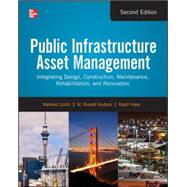The Latest Tools and Techniques for Managing Infrastructure Assets
Fully updated throughout, this practical resource provides a proven, cost-effective infrastructure asset management framework that integrates planning, design, construction, maintenance, rehabilitation, and renovation. Public Infrastructure Asset Management, Second Edition, describes the most current methodologies for effectively managing roads, bridges, airports, utility services, water and waste facilities, parks, public buildings, and sports complexes.
This comprehensive guide covers information management and decision support systems, including proprietary solutions and new technological developments such as cloud storage. The book discusses total quality management, economics, life-cycle analysis, and maintenance, rehabilitation, and reconstruction programming. Up-to-date examples and real-world case studies illustrate the practical applications of the concepts presented in this thoroughly revised reference.
This new edition features:
- Planning, needs assessment, and performance indicators
- Database management, data needs, and analysis
- Inventory, historical, and environmental data
- In-service monitoring and evaluation data
- Performance modeling and failure analysis
- Design for infrastructure service life
- Construction
- Maintenance, rehabilitation, and reconstruction strategies, policies, and treatment alternatives
- Dealing with new or alternate concepts
- Prioritization, optimization, and work programs
- Integrated infrastructure asset management systems
- Visual IMS: an illustrative infrastructure management system and applications
- Available asset management system and commercial off-the-shelf providers
- Benefits of implementing an asset management system
- Sustainability, environmental stewardship, and asset management
- Future directions for infrastructure asset management








